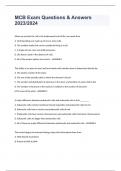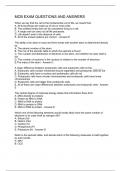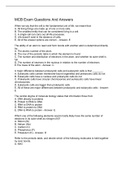Eurkaryotic Study guides, Class notes & Summaries
Looking for the best study guides, study notes and summaries about Eurkaryotic? On this page you'll find 18 study documents about Eurkaryotic.
All 18 results
Sort by
 Popular
Popular
-
Bio 121: Lab 1 & 2 RO's exam 1 Already Passed!!
- Exam (elaborations) • 7 pages • 2023
- Available in package deal
-
- $3.99
- 1x sold
- + learn more
Bifidobacterium: Prokaryotic or Eukaryotic? Autotrophic or Heterotrophic? Unicellular, Colonial, or Multicellular? - -Prokaryotic, Heterotrophic, Unicellular Bifidobacterium: Domain, Kingdom, Phylum, Common Name - Bacteria, Bacteria, Actinobacteria, Yogurt Bacterium Bifidobacterium: Habitat - Human Intestine Bifidobacterium: How is food/energy obtained? - Extracellular digestion breaks down non-living organic material and absorb nutrients from it, uses food material that its host has eaten...

-
MCB Exam Questions & Answers 2023/2024
- Exam (elaborations) • 36 pages • 2023
-
Available in package deal
-
- $10.99
- + learn more
MCB Exam Questions & Answers 2023/2024 When we say that the cell is the fundamental unit of life, we meant that: A. All living things are made up of one or more cells. B. The smallest entity that can be considered living is a cell. C. A single cell can carry out all life processes. D. Life doesn't exist in the absence of cells. E. All of the answer options are correct. - ANSWER-E The ability of an atom to react and form bonds with another atom is determined directly by: A. The...

-
MIP 300 Exam 1 Study Guides Question and answers 2023/2024 verified to pass
- Exam (elaborations) • 10 pages • 2023
-
Available in package deal
-
- $13.99
- + learn more
MIP 300 Exam 1 Study Guides Question and answers 2023/2024 verified to passCompare and contrast prokaryotic cells and eukaryotic cells - correct answer Prokaryotic cells have no nucleus or membrane organelles. Eurkaryotic cells have a nucleus and membrane bound organelles (golgi apparatus, ER, mitochondria, and lysosomes) List 4 types of cellular microbes and give a common example of each of these types of microbes - correct answer Fungi (yeast), Protozoa (lamblia causes giardia), Algae, Bact...

-
MCB EXAM QUESTIONS AND ANSWERS
- Exam (elaborations) • 25 pages • 2024
-
- $12.99
- + learn more
When we say that the cell is the fundamental unit of life, we meant that: A. All living things are made up of one or more cells. B. The smallest entity that can be considered living is a cell. C. A single cell can carry out all life processes. D. Life doesn't exist in the absence of cells. E. All of the answer options are correct. - Answer-E The ability of an atom to react and form bonds with another atom is determined directly by: A. The atomic number of the atom. B. The row of t...

-
Blueprint - P/S FL#5 questions and answers
- Exam (elaborations) • 6 pages • 2024
-
Available in package deal
-
- $12.99
- + learn more
Blueprint - P/S FL#5What is the difference between an operator and a silencer? - correct answer Operator = Prokaryotic DNA Silencer = Eurkaryotic DNA Which bases can be methylated? - correct answer A (on the NH group) and C Difference between miRNA and siRNA - correct answer miRNA = non specific, ssRNA, gene expression siRNA = v specific, dsRNA, viral defense Paul Ekman described seven universal human emotions. What are they? - correct answer anger, contempt, disgust, fear, happiness...

-
MCB Exam Questions And Answers
- Exam (elaborations) • 25 pages • 2023
-
- $12.49
- + learn more
When we say that the cell is the fundamental unit of life, we meant that: A. All living things are made up of one or more cells. B. The smallest entity that can be considered living is a cell. C. A single cell can carry out all life processes. D. Life doesn't exist in the absence of cells. E. All of the answer options are correct. - Answer- E The ability of an atom to react and form bonds with another atom is determined directly by: A. The atomic number of the atom. B. The row of ...

-
MIP 300 Exam 1 Study Guides question n answers graded A+
- Exam (elaborations) • 10 pages • 2023
- Available in package deal
-
- $17.99
- + learn more
MIP 300 Exam 1 Study GuidesCompare and contrast prokaryotic cells and eukaryotic cells - correct answer Prokaryotic cells have no nucleus or membrane organelles. Eurkaryotic cells have a nucleus and membrane bound organelles (golgi apparatus, ER, mitochondria, and lysosomes) List 4 types of cellular microbes and give a common example of each of these types of microbes - correct answer Fungi (yeast), Protozoa (lamblia causes giardia), Algae, Bacteria (mycobacterium), and Archea (themophilius) ...

-
Portage Learning - Anatomy & Physiology I-latest exam questions and answer graded
- Exam (elaborations) • 57 pages • 2024
-
- $7.99
- + learn more
Why metabolizing cells need to be small - answer Bigger cell = smaller surface area Smaller cell = larger surface area to volume; allows metabolic processes to happen faster 3 differences between eurkaryotic and prokaryotic cells - answer 1. E = Multicellular 2. E = Bigger and contain internal membrane bounded organelles 3. E = DNA enclosed in a nuclear membrane function of each organelle - answer 1. Nucleus - contians DNA and control center 2. Ribosomes - tiny manufacturing plant where pr...

-
Portage Learning - Anatomy & Physiology I Questions with correct Answers
- Exam (elaborations) • 7 pages • 2023
-
Available in package deal
-
- $20.49
- + learn more
Portage Learning - Anatomy & Physiology I Questions with correct Answers The six levels of organization of the body are 1. Chemical level -Atom, Micro-molecules 2. Cellular level - cell 3. Tissue level - tissue 4. Organ level - Organelles 5. Organ System level 6. Organism level The necessary life function that protects our internal environment from our external environment is provided by what system? Integumentary The function of movement is provided by what system? Muscu...
Describes the: evolution, flexible boundaries, cytoskeleton, evolution of the nucleus, waste digestion, and endosymbiosis

Did you know that on average a seller on Stuvia earns $82 per month selling study resources? Hmm, hint, hint. Discover all about earning on Stuvia



